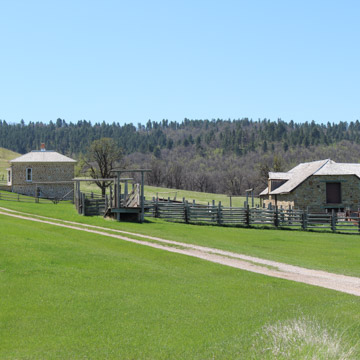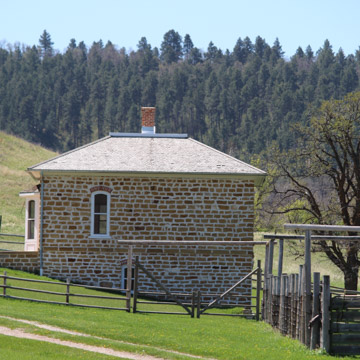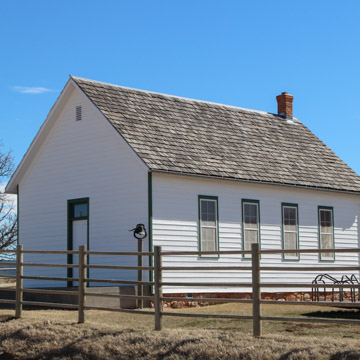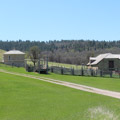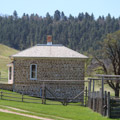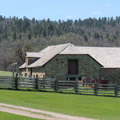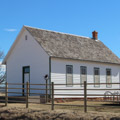Frawley Ranch is located seven miles north of Deadwood and seven miles east of Spearfish in the Black Hills. It became one of the largest cattle operations in western South Dakota and eventually encompassed 4,750 acres. In addition to Hereford cattle, the Frawleys bred Belgian and Percheron draft horses.
In 1877 young lawyer Henry J. Frawley moved from Wisconsin to Deadwood, South Dakota, and began purchasing land in Centennial Valley. In 1890, he married Christiana Anderson, the daughter of James Anderson, a prominent dairyman in the area. By 1913 Frawley’s land holdings included several existing ranches, homesteads, and roadhouses that comprised what became known as the upper, middle, lower, and east ranches. The land was ill-suited for farming, which is why Frawley was able to purchase seventeen unsuccessful homesteads and expand his ranching operation.
Frawley’s wife was the sole heir to her father’s dairy complex, which became known as the East Ranch. The property includes three significant structures: a two-story, cut-stone barn with L-shaped plan and jerkinhead roof; a cut-stone springhouse built into the side of a hill that was initially used to keep dairy products cool but then served as a watering system for cattle; and a cut-stone cottage, also built into a hillside, that appears as one story from the front and two from the rear.
The Lower Ranch includes two important structures. The two-story granary features cut-stone on the ground level and red horizontal wood siding on the second; it has a tin gable roof. The one-story bunkhouse has a cut-stone foundation and is built of double saddle-notched pine logs with lime mortar chinking.
The Middle Ranch includes the 1888 Anna and Marion Draper Roadhouse, a stop on early stage and freight routes. Here, travelers could purchase a meal and acquire lodging in one of the two-story building’s seventeen rooms. The Colonial Revival structure features clapboard siding and a wood-shingled hipped roof with large front dormer. A two-story, cut-stone pump house (1888) brought water to the Draper Roadhouse from a hand-dug well. Also on this portion of the ranch is an 1880 schoolhouse. The single-story, one-room structure, which ceased operation as a school in 1936, was restored in 2004 and features the original desks, blackboard, and stove.
The Upper Ranch was established in 1891. The Centennial Park Hotel and a post office were two of the structures originally on this land, but after they were destroyed by fire, Frawley used the property for cattle grazing. Two courtyard-style barns are unique features of the ranch, and were rebuilt in 1913 after a fire destroyed the original buildings. The larger of the two is a combination of wood siding and cut stone; the latter of which forms the entire south wall. There are several cupolas for ventilation on the tin-covered gable roof. Three open stalls are offset to the left of the main entrance, and additional stalls, a small corral, and several haylofts occupy the remainder of the two-story structure.
Other features of the ranch include a Sioux burial ground on top of Elkhorn Peak; a cemetery started in 1880 that includes graves of several early white settlers; and the foundations, dugouts, and hand-dug wells of the early homesteads. Along with the cattle ranch, these sites and structures provide a unique portrait of turn-of-the-century life in western South Dakota. The Frawley family continued to own the ranch until the 1990s, when the property was purchased for development as part of the Elkhorn Ridge, a resort that includes a golf course and other athletic facilities, campsites and an RV park, various forms of lodging, and an event center. The historic buildings are intact and many of them have been restored.










